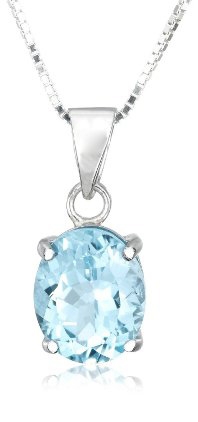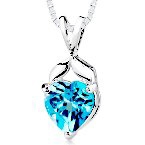TOPAZ is one of the most popular yellow and blue stone in jewelry. It is often the principal stone in brooches or pendants, especially in old-fashioned jewelry items. In the past it has been a general idea that all yellow stones are topazes, and that all topazes are yellow. However, neither of these statements are correct.
It can happen that a yellow stone pretending to be topaz is in reality the yellow quartz known as citrine. Many species besides citrine yield yellow stones. For example, corundum includes the beautiful, so called “oriental topaz” which is in fact yellow sapphire. Yellow tourmalines are not uncommon as it is also the case with the yellow chrysoberyl which always has a slight greenish shade.
The term Topaz was first mentioned in the Middle Ages and was used to denote any yellow stone. Gradually it was applied more particularly to the topaz of today. The true topaz was probably included by Pliny under the name chrysolithus. The name of this species originates from the expression topazion (to seek), and this was the name given to an island in the Red Sea, which in ancient times was difficult to find.
Cut and Color of Topaz
Topaz is in general brilliant-cut on the front side and step-cut at the back. Its largest, table facet is sometimes rounded. If the stone is colorless it may be cut as a small brilliant. It can take an excellent and dazzling polish.

In contrast to the general idea, topaz is usually colorless, provided that it is sufficiently pure. It can also have a very pale color, but if there are impurities in the structure, topaz will assume color. Yellow hues of different degrees, from pale to a rich sherry shades, are not uncommon. There are topazes of pure pale blue and pale green color, which often pass as aquamarine. The blue topaz color is very abundant.
Natural, red and pink, topazes are very rare. A feature of the brownish-yellow topaz stones from Brazil is that the color can be altered by heating to a dazzling rose-pink. Strangely, the color is not apparent when the stone is heat treated – it is only developed as the stone is cooled down to room temperature.
Heat treated gemstones are common in modern jewelry. Although the change in color is accompanied by some slight rearrangement of the constituent molecules, it appears to be permanent.
Physical Properties of Topaz
Topaz is an aluminum silicate with the chemical formula [Al(F,OH)] 2Si04.
The symmetry of this crystal is orthorhombic, and the crystals are prismatic in shape and terminated by numerous inclined faces. Usually, there is a large face perpendicular to the prism edge. Topaz cleaves very easily at right angles to the prism edge. Because of this type of facile cleavage, flaws and dislocations are easily generated and caution is advised not to damage the stone against hard and inflexible materials.
The dichroism of a yellow topaz is always easily noticeable. One of the twin colors is distinctly more red than the other. This feature is markedly visible in the case of a stone whose color has been altered to pink in a laboratory.
The hardness of this crystal is 8 on Mohs’s scale, which is a relatively high value and in this case only a handful of gemstones have larger values: chrysoberyl, corundum, and diamond.
Topaz is piezo-electric, and only tourmaline exceeds its piezo-electric properties. Piezoelectricity means that and it may be strongly electrified by friction and/or pressure. Although the range of refraction overlaps that of tourmaline, these two gemstones are easily distinguished, because the tourmaline has more than three times the amount of double refraction.
The Price of Topaz
 Considering the price of topaz, this stone is not at the top of the list of precious stones. Stones that possess good color and are free from flaws are not so common as one might believe. Pale stones are worth very little, but the price rapidly increases with the intensity of color, for example, for yellow yellow topazes, while the pink and blue stones are the most expensive.
Considering the price of topaz, this stone is not at the top of the list of precious stones. Stones that possess good color and are free from flaws are not so common as one might believe. Pale stones are worth very little, but the price rapidly increases with the intensity of color, for example, for yellow yellow topazes, while the pink and blue stones are the most expensive.
Since topazes are procurable in all sizes customary in jewelry, the rates vary but slightly, if at all, with the size. Topaz occurs principally in pegmatite dykes and in cavities in granite, and is interesting to geologists as a an example of the result of the action of hot acid vapors upon rocks rich in aluminum silicates.
Metaphysical Meaning of Topaz
Topaz encourages truth and forgiveness and promotes a feeling of joy and happiness. It helps us find our own path in life. It improves the awareness of every our thought, feeling and deed, and of their karmic effects. Topaz also activates the Cosmic consciousness. It can help remove the stale energies and direct new vital energy wherever it might be needed. This crystal is a symbol of chastity, happiness, friendship and hope. The healing energies of topaz bring spiritual renewal and rejuvenation, eliminating, at the same time, rage and anger. Topaz harmonizes our emotions and soothes our passions. It corresponds to the Crown chakra and to the astrological signs of Sagittarius and Virgo.
Topaz and Crystal Healing
Topaz is a powerful stone capable of strengthening the whole organism. It balances, soothes and cleanses our emotions and guides our actions. It eliminates tension and brings joy, love and peace. In crystal healing it treats blood disorders, improves the appetite, restores the tissues, prevents rapid aging, helps with tuberculosis and asthma and balances the endocrine system. There is a variety of beautiful crystal healing topaz jewelry you can use in your everyday life.
